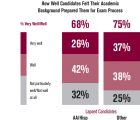 If you are an actuary practicing for a business in the U.S., the Code of Professional Conduct (the Code) applies to you. You may have the “little blue book” close at hand, ready to refer to any of the 14 precepts contained within (I personally keep mine on my desk).[1] Or your familiarity may stop at what you learned in your actuarial society’s professionalism course.
If you are an actuary practicing for a business in the U.S., the Code of Professional Conduct (the Code) applies to you. You may have the “little blue book” close at hand, ready to refer to any of the 14 precepts contained within (I personally keep mine on my desk).[1] Or your familiarity may stop at what you learned in your actuarial society’s professionalism course.
The Code allows us to uphold the reputation of the actuarial profession, permitting our profession to continue to be self-regulated. Other professions, such as doctors and lawyers, have regulatory bodies that supervise the actions of their members, enforcing their responsibilities to the public. This article covers each precept, providing examples to illustrate ways to maintain public trust. I’ll start with some background on the Code.
History and purpose
There are five U.S.-based actuarial organizations.[2] Prior to 1992, each of these organizations had their own guidelines. Actuaries who belonged to more than one, such as the American Academy of Actuaries (AAA) and the CAS, had to comply with all applicable rules, and there were inconsistencies that could cause potential conflict.
A Joint Committee on the Code of Professional Conduct was formed to develop a unified Code that became effective January 1, 2001, and was adopted by all five organizations.
The purpose of the Code is to “require Actuaries to adhere to the high standards of conduct, practice and qualifications of the actuarial profession.…”[3] A violation of the Code could result in disciplinary action and tarnish the reputation of the actuary in violation and the profession.
In the Code, the term Actuary (capitalized) is defined as “an individual who has been admitted to a class of membership to which the Code applies by action of any organization having adopted the Code.” A Member of the AAA (MAAA) or a Fellow of the CAS (FCAS) would both be considered an Actuary. “The uncapitalized ‘actuary’ refers to any individual practicing as an actuary, regardless of organizational membership or classification.”[4]
The following precepts describe the behaviors and actions that are necessary to comply with the Code.
Precept 1: Professional Integrity
“An Actuary shall act honestly, with integrity and competence and in a manner to fulfill the profession’s responsibility to the public and to uphold the reputation of the actuarial profession.”
Because of the overarching nature of Precept 1, a violation of any of the other 13 precepts will also likely result in a violation of this precept. According to the 2022 Annual Report from the Actuarial Board of Counseling and Discipline (ABCD), Precept 1 was the most violated of the 14 precepts.[5] The report shows the number of inquiries for the year (22) and provides a summary of alleged violations by precept. Some inquiries involved multiple issues, but 41 of 50 issues alleged were related to Precept 1.
Violations of Precept 1 fall into three separate categories:
- Failure to act with integrity: When an Actuary performs Actuarial Services,[6] they are to exercise skill and care. I use the “mirror test” as a guideline for this. If, in performing Actuarial Services, you can’t look at yourself in the mirror because of your actions, you are likely violating Precept 1.
An example is intentionally understating reserves due to pressure from your Principal.
Fourteen of the 41 issues alleged related to this category.
- Failure to perform services with competence: Actuaries undergo rigorous educational and experience requirements to exercise skill and care. Performing actuarial services outside of your expertise would violate Precept 1.
Some examples are a life Actuary performing services for a casualty line of business or a casualty Actuary with commercial insurance reserving experience setting rates for homeowners insurance. You should be working with another Actuary who has the appropriate experience if you are working outside of your area of expertise.
Seven of the 41 issues alleged related to this category.
- Failure to uphold the reputation of the actuarial profession: A lot of focus is placed on violations that happen while performing Actuarial Services, but violations of Precept 1 can stem from what we do in our personal lives as well.
For example, if you are charged with criminal activity, such as driving under the influence (DUI), and it is highlighted that you are an Actuary, the reputation of the profession could be tarnished and you would be in violation of Precept 1.
Twenty of the 41 issues alleged related to this category.
The USQS outlines the amount and type of CE hours required to attest that you are qualified to perform Actuarial Services for the following year.
Precept 2: Qualification Standards
“An Actuary shall perform Actuarial Services only when the Actuary is qualified to do so on the basis of basic and continuing education and experience, and only when the Actuary satisfies applicable qualification standards.”
The U.S. Qualification Standards (USQS) outline the three requirements to comply with the Code:
- Basic education: The examination process[7] for your Recognized Actuarial Organization (RAO).[8]
- Continuing education (CE): Once you obtain your credentials, you must fulfill CE requirements. The USQS outlines the amount and type of CE hours required to attest that you are qualified to perform Actuarial Services for the following year.[9] You also must determine if CE is relevant and track your hours in case your CE log is reviewed.[10]
- Experience: The USQS requires that you have three years of experience before you perform Actuarial Services in a given area. For example, if you are a new Associate of the SOA (ASA) with only two years of applicable experience, you wouldn’t be in full compliance to provide Actuarial Services on your own.
This precept also discusses the jurisdiction where the Actuary renders Actuarial Services. If you are a Canadian Institutes of Actuaries (CIA) member practicing in the U.S., you must adhere to the USQS. CIA members who practice only in Canada must adhere to their own jurisdictional code. If you are an Actuary living in the U.S. and provide Actuarial Services for a Principal[11] in another jurisdiction, you will adhere to that jurisdiction’s code.

Precept 3: Standards of Practice
“An Actuary shall ensure that the Actuarial Services performed by or under the direction of the Actuary satisfy applicable standards of practice.”
Actuarial Standards of Practice (ASOPs)[12] are promulgated by the Actuarial Standards Board (ASB) to provide guidance on how to perform specific functions of actuarial work. For example, ASOP 23, “Data Quality,” provides guidance to the Actuary when performing Actuarial Services involving data.[13]
If you provide Actuarial Services involving data and do not follow the guidance of ASOP 23, then you may be in violation of Precept 3. If you start working in a new area and don’t know which ASOPs may apply, the AAA has developed applicability guidelines matching ASOPs to particular tasks.[14] The applicability guidelines are helpful but are not binding or comprehensive. It is your responsibility to stay current on ASOP additions and changes to ensure you are adhering to Precept 3.[15]
It is your responsibility to stay current on ASOP additions and changes to ensure you are adhering to Precept 3.
Precepts 4, 5 and 6: Communication and Disclosure
“An Actuary who issues an Actuarial Communication[16] should take appropriate steps to ensure that the Actuarial Communication is clear and appropriate to the circumstances and its intended audience, and satisfies applicable standards of practice.” (Precept 4)
“An Actuary who issues an Actuarial Communication shall, as appropriate, identify the Principal(s) for whom the Actuarial Communication is issued and describe the capacity in which the Actuary serves.” (Precept 5)
Precepts 4 and 5 require identification of the responsible Actuary, clarification of the availability of additional supplementary information, and identification of the Principal when providing Actuarial Services.
“An Actuary shall make appropriate and timely disclosure to a present or prospective Principal of the sources of all direct and indirect material compensation that the Actuary or the Actuary’s firm has received, or may receive, from another party in relation to an assignment for which the Actuary has provided, or will provide, Actuarial Services for that Principal.” (Precept 6)
If you were building a single model to fulfill the needs of multiple clients, and you billed each client 100% of the time charges to build the model without disclosing that they were not the sole Principal, that might be a violation of Precept 6.
Watch this space
We are only half way through the Code. We’ve covered the history and purpose of the code, Professional Integrity, Qualification Standards, Standards of Practice, and Communication and Disclosure. Next issue, we will wrap it up with the remaining precepts covering Conflict of Interest, Control of Work Product, Confidentiality, Courtesy and Cooperation, Advertising, Titles and Designations, Violations of the Code, and the candidate codes of ethics.
In the meantime, please send us any questions or comments via email to ar@casact.org.
[1]https://www.actuary.org/content/code-professional-conduct.
[2] American Academy of Actuaries (AAA), American Society of Pension Professionals & Actuaries (ASPPA), Casualty Actuarial Society (CAS), Conference of Consulting Actuaries (CCA), and Society of Actuaries (SOA). Members of the Canadian Institutes of Actuaries (CIA) practicing in the US must also comply with the Code.
[3] The Code, page 1.
[4] The Code, page 1.
[5] 2022 ABCD annual report. http://www.abcdboard.org/resources/annual/.
[6] The Code defines Actuarial Services as “professional services provided to a Principal by an individual acting in the capacity of an actuary.”
[7] The examination process is part of the basic education requirement; for additional details, review the USQS.
[8] The Code defines a “Recognized Actuarial Organization” as “an organization that has been accepted for full membership in the International Actuarial Association or a standards-setting, counseling, or discipline body to which authority has been delegated by such an organization.”
[9] Reading this article may count as professionalism CE for you.
[10] All this information, and more, can be found at: https://www.actuary.org/content/us-qualification-standards. Also, see CE Requirements and Compliance article in Jan/Feb 2024 Actuarial Review.
[11] The Code defines Principal as “a client or employer of the Actuary.”
[12]https://www.actuary.org/content/actuarial-standards-practice-asops.
[13]http://www.actuarialstandardsboard.org/asops/data-quality/.
[14]https://www.actuary.org/content/applicability-guidelines-actuarial-standards-practice-0.
[15] The AAA periodically publishes the ASB Boxscore with the status of the ASOP changes. http://www.actuarialstandardsboard.org/boxscore/.
[16] The Code defines Actuarial Communication as “a written, electronic, or oral communication issued by an Actuary with respect to Actuarial Services.”











